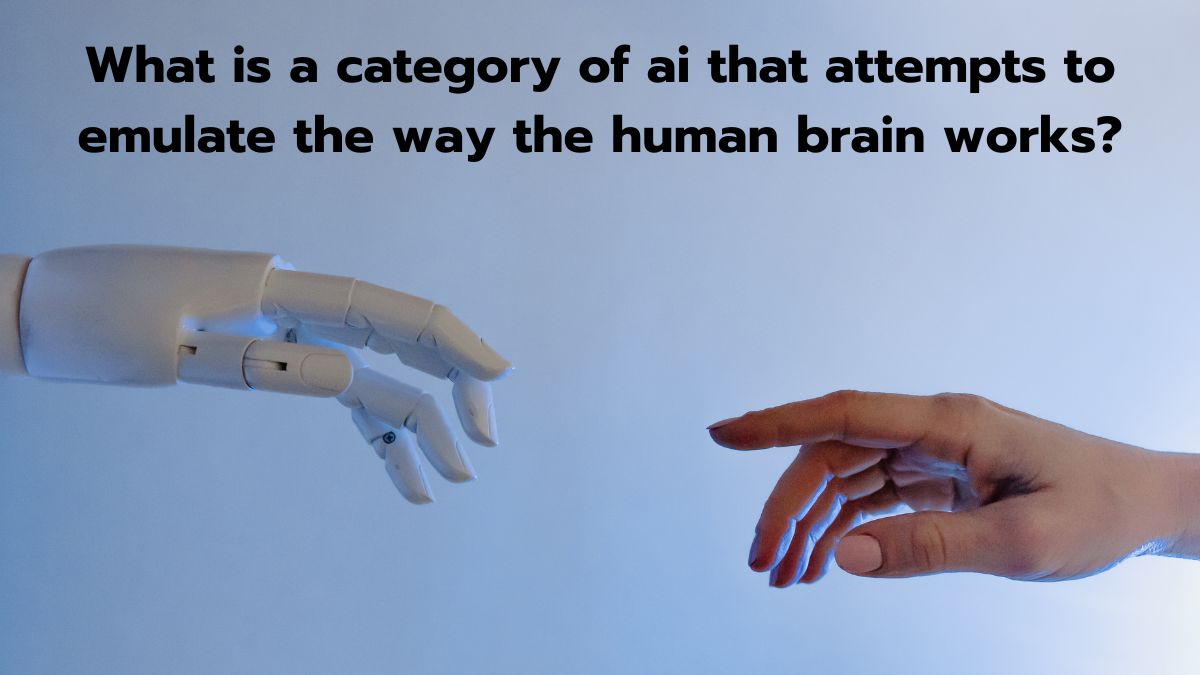Artificial intelligence (AI) is a broad field, but one category stands out for its attempt to emulate the way the human brain works: neural networks. Neural networks are a type of AI modeled after the human brain’s structure and function. This article will explore what neural networks are, how they work, and their applications, all explained in an easy-to-understand way.
Table of Contents
What is a category of ai that attempts to emulate the way the human brain works?

What are Neural Networks?
Neural networks are a subset of AI and machine learning. They are inspired by the human brain’s network of neurons. Just like our brains use neurons to process information, neural networks use artificial neurons, also known as nodes or units, to process data.
The human brain consists of billions of neurons interconnected by synapses. These neurons transmit signals to each other, helping us think, learn, and remember. Neural networks try to mimic this process using a system of interconnected nodes. Each node performs a simple calculation, and together, they can solve complex problems.
How Do Neural Networks Work?
Neural networks consist of layers of nodes. There are three main types of layers:
- Input Layer: This layer receives the raw data. For example, in an image recognition task, the input layer would receive the pixel data from the image.
- Hidden Layers: These layers sit between the input and output layers. They perform the actual processing and computation. There can be one or many hidden layers, each adding more complexity and power to the network.
- Output Layer: This layer produces the final result. For instance, in an image recognition task, the output layer might produce the label of the object detected in the image.
When data is fed into the input layer, it passes through the hidden layers. Each node in the hidden layer takes the output from the previous layer, applies a mathematical function to it, and passes the result to the next layer. This process continues until the data reaches the output layer.
Learning Process
Neural networks learn through a process called training. During training, the network is fed a large amount of data and adjusts its internal parameters to minimize errors. This is similar to how humans learn from experience.
For example, imagine training a neural network to recognize cats in photos. You would provide the network with many labeled images of cats and non-cats. The network would make predictions and compare them to the correct labels. When it makes a mistake, it adjusts its parameters to reduce the error. Over time, the network improves its accuracy.
Types of Neural Networks
There are several types of neural networks, each designed for specific tasks:
- Feedforward Neural Networks: The simplest type, where data moves in one direction from input to output.
- Convolutional Neural Networks (CNNs): Specialized for processing grid-like data such as images. CNNs are widely used in image and video recognition.
- Recurrent Neural Networks (RNNs): Designed for sequence data, such as time series or natural language. RNNs are used in tasks like language translation and speech recognition.
- Generative Adversarial Networks (GANs): Consist of two networks, one generating data and the other evaluating it. GANs are used for creating realistic images, videos, and other content.
Applications of Neural Networks
Neural networks have a wide range of applications in various fields:
- Image and Speech Recognition: Neural networks can identify objects in images and transcribe spoken words into text. This technology is used in smartphones, smart speakers, and other devices.
- Natural Language Processing: Neural networks help computers understand and generate human language. This is used in chatbots, translation services, and virtual assistants like Siri and Alexa.
- Healthcare: Neural networks assist in diagnosing diseases from medical images, predicting patient outcomes, and personalizing treatments.
- Finance: They are used for predicting stock prices, detecting fraudulent transactions, and managing risks.
- Autonomous Vehicles: Neural networks help self-driving cars recognize objects, navigate roads, and make driving decisions.
- Gaming: AI opponents in video games use neural networks to learn and adapt to players’ strategies.
Advantages of Neural Networks
Neural networks offer several advantages:
- Accuracy: They can achieve high accuracy in tasks like image and speech recognition.
- Adaptability: Neural networks can learn and adapt to new data, making them versatile.
- Automation: They can automate complex tasks, reducing the need for human intervention.
Challenges and Future Directions
Despite their advantages, neural networks also face challenges:
- Data Requirements: They require large amounts of data for training.
- Computational Power: Training neural networks is computationally intensive and requires powerful hardware.
- Interpretability: It can be difficult to understand how neural networks make decisions.
Looking ahead, researchers are working on improving neural networks’ efficiency, interpretability, and ability to learn from less data. Advances in quantum computing and neuromorphic computing (hardware that mimics the brain’s structure) hold promise for the future of neural networks.
New AI Works Just Like a Brain
Conclusion
Neural networks represent a significant step toward creating AI that mimics the human brain. Their ability to learn from data and perform complex tasks has revolutionized many industries, from healthcare to finance to autonomous vehicles. As technology advances, neural networks will continue to play a crucial role in shaping the future of AI, bringing us closer to machines that can think and learn like humans.

Pingback: Instagram marketing for beginners: Step-by-step guide - Rank Web Tools